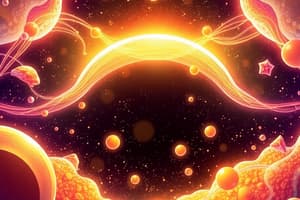Podcast
Questions and Answers
What is the characteristic feature of monosaccharides occurring in mammals?
What is the characteristic feature of monosaccharides occurring in mammals?
They are D-sugars.
What is the ability of a substance to rotate the plane of polarization of a beam of light that is passed through it?
What is the ability of a substance to rotate the plane of polarization of a beam of light that is passed through it?
Optical Activity.
What is the term for a mixture of equal amounts of dextrorotatory and laevorotatory isomers?
What is the term for a mixture of equal amounts of dextrorotatory and laevorotatory isomers?
Racemic.
What is the process of separating optically active isomers from a racemic mixture?
What is the process of separating optically active isomers from a racemic mixture?
What is the term for the carbon atom that has four different groups attached to it after cyclization?
What is the term for the carbon atom that has four different groups attached to it after cyclization?
What is the name of the glucose molecule formed when the OH group extends to the right?
What is the name of the glucose molecule formed when the OH group extends to the right?
What is the term for the type of glucose molecule that is formed when the aldehyde group on carbon-1 condenses with the alcoholic-OH group on carbon-5?
What is the term for the type of glucose molecule that is formed when the aldehyde group on carbon-1 condenses with the alcoholic-OH group on carbon-5?
What determines the optical activity of a compound?
What determines the optical activity of a compound?
What is the term for the type of isomers that rotate the plane of polarization of light to the right or left?
What is the term for the type of isomers that rotate the plane of polarization of light to the right or left?
What is the term for the type of glucose molecule that is formed when the OH group extends to the left?
What is the term for the type of glucose molecule that is formed when the OH group extends to the left?
Flashcards are hidden until you start studying
Study Notes
Carbohydrates
- Maltose yields two molecules of glucose on hydrolysis.
- Lactose (milk sugar) is found in milk, occurs as an equilibrium mixture of α and β forms at body temperature, and is not very soluble or sweet.
- Lactose is dextrorotatory and yields one molecule of D-Glucose and one molecule of D-Galactose on hydrolysis by the enzyme lactase.
- Lactose has reducing properties and can form α and β forms, exhibiting mutarotation.
Sucrose
- Sucrose is ordinary table sugar, also known as 'Cane sugar', obtained from sugarcane, sugar beet, and sugar maple.
- Sucrose is very soluble and sweet, and yields one molecule of D-Glucose and one molecule of D-Fructose on hydrolysis by the enzyme sucrase.
- Sucrose does not have reducing properties due to its linked aldehyde and ketone groups.
- Sucrose is dextrorotatory, but its hydrolytic products (glucose and fructose) are levorotatory, resulting in 'Invert Sugar' and the process of 'Inversion'.
Polysaccharides
- Polysaccharides are complex substances, polymerized products of many monosaccharide units.
- Examples include amylopectin, a polymer of D-Glucose units, with glucose units joined by α1 → 4 glucosidic linkages and branching at branch points by α1 → 6 glucosidic linkage.
- Inulin is a polymer of D-fructose, has a low molecular weight, and is found in the bulbs of onion and garlic.
- Inulin is levorotatory, gives no color with iodine, and is hydrolysed by acids or the enzyme inulinase.
- Cellulose is a polymer of glucose, found in the cell walls of plants, and is not of nutritional value in humans.
- Dextrins are products of lower molecular weight formed by the partial hydrolysis of starch by acids or enzymes.
- Dextran is a polymer of D-Glucose, made up of units of D-Glucose molecules, and is used as a plasma expander.
- Agar is a homopolysaccharide made up of repeated units of galactose, which is sulphated, and is present in seaweed.
Optical Activity
- Optical activity is the ability of a substance to rotate the plane of polarization of a beam of light passed through it.
- The presence of asymmetric carbon atoms confers optical activity on a compound.
- Dextrorotatory compounds rotate the plane of polarization to the right, while laevorotatory compounds rotate it to the left.
- A racemic mixture is a mixture of equal amounts of dextrorotatory and laevorotatory isomers, which has no optical activity.
- Resolution is the separation of optically active isomers from a racemic mixture.
Cyclic Structures
- The open-chain form of D-Glucose can be condensed to form two different forms of glucose, α-D-Glucose and β-D-Glucose, through cyclization.
- Carbon-1 becomes asymmetric after cyclization, with four different groups attached to it.
Studying That Suits You
Use AI to generate personalized quizzes and flashcards to suit your learning preferences.




